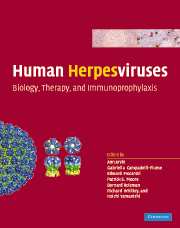Book contents
- Frontmatter
- Contents
- List of contributors
- Preface
- Part I Introduction: definition and classification of the human herpesviruses
- Part II Basic virology and viral gene effects on host cell functions: alphaherpesviruses
- Part II Basic virology and viral gene effects on host cell functions: betaherpesviruses
- 14 Comparative betaherpes viral genome and virion structure
- 15 Betaherpes viral genes and their functions
- 16 Early events in human cytomegalovirus infection
- 17 Immediate–early CMV gene regulation and function
- 18 Early CMV gene expression and function
- 19 CMV DNA synthesis and late viral gene expression
- 20 CMV maturation and egress
- 21 CMV modulation of the host response to infection
- Part II Basic virology and viral gene effects on host cell functions: gammaherpesviruses
- Part III Pathogenesis, clinical disease, host response, and epidemiology: HSV-1 and HSV-2
- Part III Pathogenesis, clinical disease, host response, and epidemiology: VZU
- Part III Pathogenesis, clinical disease, host response, and epidemiology: HCMV
- Part III Pathogenesis, clinical disease, host response, and epidemiology: HHV- 6A, 6B, and 7
- Part III Pathogenesis, clinical disease, host response, and epidemiology: gammaherpesviruses
- Part IV Non-human primate herpesviruses
- Part V Subversion of adaptive immunity
- Part VI Antiviral therapy
- Part VII Vaccines and immunothgerapy
- Part VIII Herpes as therapeutic agents
- Index
- Plate section
- References
14 - Comparative betaherpes viral genome and virion structure
from Part II - Basic virology and viral gene effects on host cell functions: betaherpesviruses
Published online by Cambridge University Press: 24 December 2009
- Frontmatter
- Contents
- List of contributors
- Preface
- Part I Introduction: definition and classification of the human herpesviruses
- Part II Basic virology and viral gene effects on host cell functions: alphaherpesviruses
- Part II Basic virology and viral gene effects on host cell functions: betaherpesviruses
- 14 Comparative betaherpes viral genome and virion structure
- 15 Betaherpes viral genes and their functions
- 16 Early events in human cytomegalovirus infection
- 17 Immediate–early CMV gene regulation and function
- 18 Early CMV gene expression and function
- 19 CMV DNA synthesis and late viral gene expression
- 20 CMV maturation and egress
- 21 CMV modulation of the host response to infection
- Part II Basic virology and viral gene effects on host cell functions: gammaherpesviruses
- Part III Pathogenesis, clinical disease, host response, and epidemiology: HSV-1 and HSV-2
- Part III Pathogenesis, clinical disease, host response, and epidemiology: VZU
- Part III Pathogenesis, clinical disease, host response, and epidemiology: HCMV
- Part III Pathogenesis, clinical disease, host response, and epidemiology: HHV- 6A, 6B, and 7
- Part III Pathogenesis, clinical disease, host response, and epidemiology: gammaherpesviruses
- Part IV Non-human primate herpesviruses
- Part V Subversion of adaptive immunity
- Part VI Antiviral therapy
- Part VII Vaccines and immunothgerapy
- Part VIII Herpes as therapeutic agents
- Index
- Plate section
- References
Summary
Introduction
The two major lineages in the Betaherpesvirinae are the cytomegaloviruses (the Cytomegalovirus and Muromegalovirus genera, plus a number of other viruses whose taxonomy is only partially defined) and the Roseolovirus genus (see Chapter 1). The best characterized members of these lineages are HCMV (the prototype of the subfamily) and HHV-6, respectively. Cytomegaloviruses are present in a wide range of mammalian species, and have been termed “salivary gland viruses” because of their ease of isolation from explanted tissue. An earlier divergence of the Betaherpesvirinae may be represented by a herpesvirus of elephants (Richman et al., 1999; Ehlers et al., 2001). This chapter starts by describing the genome structures of Betaherpesvirinae, then examines the genetic content of HCMV and HHV-6, and finally focuses on the virion structure of HCMV.
Genome structures
The genomes of viruses in the Roseolovirus genus are significantly smaller, at 145–162 kbp, than those of other Betaherpesvirinae, at 196–241 kbp. Indeed, HCMV has the largest genome among the human herpesviruses, and thus far its closest relative, CCMV, has the largest genome of all sequenced herpesviruses. It seems likely that the ancestor of the Betaherpesvirinae had a genome consisting of a unique region flanked by a direct repeat (the class A genome described in Chapter 2), since this structure is characteristic of most extant members of the subfamily. Earlier studies ruled out the presence of large repeats in the genomes of MCMV (Ebeling et al., 1983a; Mercer et al., 1983; Marks and Spector, 1984), THV (Koch et al., 1985) and RCMV (Meijer et al., 1986).
- Type
- Chapter
- Information
- Human HerpesvirusesBiology, Therapy, and Immunoprophylaxis, pp. 177 - 203Publisher: Cambridge University PressPrint publication year: 2007
References
- 9
- Cited by

